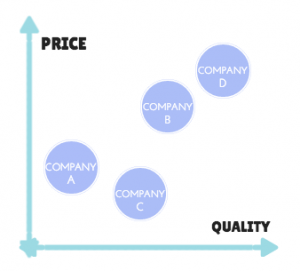
How to Find your Market Position
Marketers often talk about “Market Positioning” – but what does it really mean? And do you really need to know what yours is?
When some people say “market position” – they mean “share of market” – i.e. are you #1 or #2, in terms of having the largest share (biggest sales vs. your competitors) of the overall market. But most marketers use “market positioning” to refer to conceptual look at the market, and the various players’ brand concepts within that market. The most common aspects  are price and quality. For example:
are price and quality. For example:
Price and Quality seem like obvious ways to rate your business versus competitors. However, there might be many other important parameters (besides just price and quality) that make the difference. For example, speed, turnaround, safety, level of knowledge, relationship, or other qualities. So how do you determine what market positioning parameters are important, and then where to position your business versus competitors? And why does it matter?
Why Market Positioning Matters
Market positioning matters exactly as much as the parameters of that market position matter to your target customers – no more and no less. They are really like the same thing. If speed of delivery/turnaround is what matters most to your customers most, then your market position on this is important, and you should be actively working on improving it.
What Market Positioning Axes Do You Need?
The only, and I mean only, place to start to find a market position is by asking your target customers what is important to them when it comes to making a buying decision about your types of services or products. Never assume it is price and quality. Price might be the last thing on anyone’s mind, decision-wise. In our experience, if you talk to even 10 – 12, you’ll find that there are quite consistent answers from one person to the next, in almost any given market. These important parameters become your X and Y axis – or you can get fancy and add a third dimension, or compare various pairings of characteristics.
For example, let’s say you have a courier business. You’ve spoken to a group of your customers (let’s say they are executive assistance or legal assistants) and they reveal that delivery speed is crucial, and price is somewhat important – but as long as the price reasonable, speed is really the most important. So you choose to use speed and price as your X and Y axis on which to find your position.
Where Are You Positioned Now?
If you’ve been in business for awhile, finding your position can be determined by asking your existing clients what your strengths are, and why they chose to use you as a vendor.
Where are your Competitors Positioned?
The hard part is really uncovering where your position is versus competitors. To assess this, excellent competitor intelligence is required.
This leads us to market research – and this will be the key way you can reveal your position in the market. This could include:
- Having discussions with your existing customers
- Surveying broad market segments to determine brand awareness/position of various competitors
- Using online data to determine which keywords your competitors are ranking on, and aiming towards
- Completing a detailed review of competitor messaging (online and offline) to determine where competitors are attempting to position themselves.
Any or all of the above research will help you understand where you are positioned.
What Market Positioning Do You WANT?
Once your company and its competitors have been positioned on a grid, this will make it easier to determine where “gaps” of opportunity may lie. Perhaps there is no one at the very high end of a certain axes. Perhaps there is a strong need (consider this a positioning axis) that you consumers have identified that none of your competitors is fulfilling currently. This is where you can find that best direction and begin steering your business toward it.
This is the essence of uncovering your best marketing strategy, and giving you clear direction and focus.
As we have said time and again – great strategy always begins with excellent market research.

